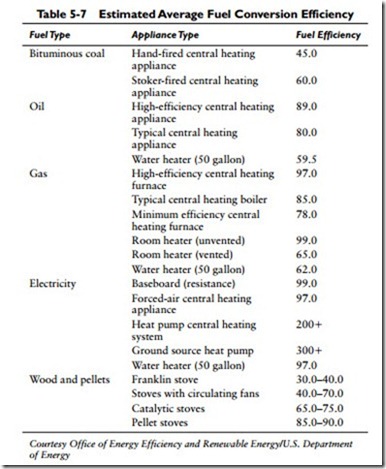Comparing Heating Fuel Costs
The cost of a heating fuel, its energy content, and the efficiency by which it is converted to useful heat are important factors for consideration when choosing a heating system. Table 5-1 lists the common heating fuels and their energy content (Btu/unit). Comparisons can be made by selecting one type of fuel (e.g., fuel oil) and a specific amount of that fuel oil (e.g., 100 gallons) as a basis for making a comparison in terms of their energy content and cost. Using the data provided in Table 5-1, one can see that 100 gallons of No. 2 fuel oil has an energy content of 14,000,000 British thermal units. That is roughly equivalent to 70 percent of a cord of air dried wood, a half ton of coal, or a little less than 14,000 cubic feet of natural gas. Multiply these figures by the cost per gallon (oil), cord (wood), ton (coal), or cubic foot (natural gas) in the area where the structure is located, and you have a cost basis for comparing heating fuels.
Another factor to consider when comparing heating fuel costs is the efficiency of the heating appliance itself. In other words, how efficient is the heating appliance (furnace, boiler, water heater, etc.) in turning a particular fuel into heat energy? Table 5-7 lists a variety of different heating appliances and their average fuel con- version efficiencies with different fuels.
In forced-warm-air heating systems and hydronic heating systems, the heated air or hot water is forced through the ducts or pipes by fans or pumps. The fans or pumps are operated by electricity, which is an additional cost when using these types of heating systems.
